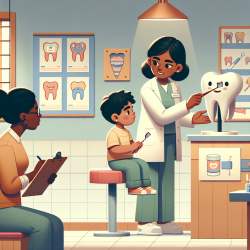In our journey to provide effective online therapy services to schools, understanding the latest research can significantly enhance our practice. One such important study is "Behavioral guidance for improving dental care in autistic spectrum disorders" by Pastore et al. This research provides valuable insights on improving dental care for children with autism spectrum disorders (ASD). Let's explore how you can implement these findings in your practice.
Understanding the Challenges
Children with ASD often face significant challenges in dental settings due to sensory sensitivities, communication difficulties, and behavioral issues. These challenges can make routine dental care daunting, often leading to dental treatments being performed under general anesthesia. The study highlights that improved behavioral guidance can significantly enhance compliance and reduce the need for such invasive measures.
Key Findings
The research conducted a quasi-experimental study involving two groups of children with ASD. The first group received regular behavioral support, including visual aids, caregiver training, and extended visit durations, while the control group followed standard care guidelines. The results were promising:
- Improved Collaboration: The group receiving behavioral support showed a significant improvement in collaboration after one year, unlike the control group.
- Reduced Need for General Anesthesia: Half of the dental treatments in the supported group were possible without general anesthesia.
- Enhanced Oral Hygiene: Both in-clinic and at-home oral hygiene practices improved in the supported group.
Implementing Behavioral Guidance in Your Practice
Based on these findings, here are some practical steps you can take to improve dental care for children with ASD:
- Use Visual Aids: Incorporate visual pedagogy tools to help children understand and anticipate the dental procedures. This can reduce anxiety and improve cooperation.
- Caregiver Training: Train caregivers on how to prepare and support their children for dental visits. This includes familiarizing the child with the dental environment and practicing oral hygiene at home.
- Extended Visit Durations: Allocate longer appointment times to allow children to acclimate to the dental setting and interact comfortably with the dental professionals.
- Consistency: Ensure that the same dental professionals handle the child's visits to build trust and reduce anxiety.
Encouraging Further Research
While this study provides a solid foundation, continued research is essential. Encourage your team to stay updated with the latest findings and consider conducting your own studies to explore additional techniques that could further improve dental care for children with ASD.
Conclusion
Implementing behavioral guidance strategies can make a significant difference in the dental care of children with ASD. By using visual aids, training caregivers, extending visit durations, and ensuring consistency, you can enhance collaboration and reduce the need for invasive treatments.
To read the original research paper, please follow this link: Behavioral guidance for improving dental care in autistic spectrum disorders.










